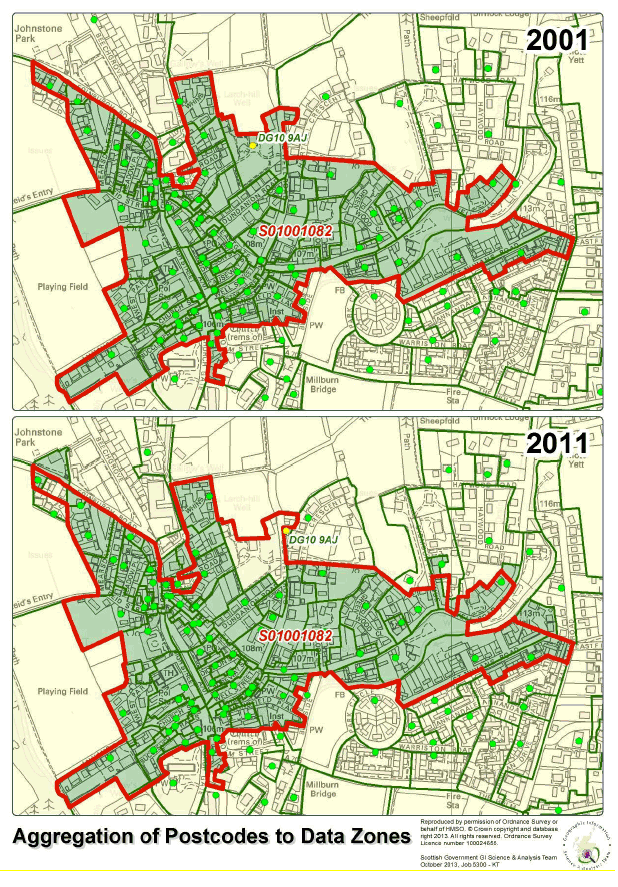Consultation regarding the redraw of Data Zones
This consultation contains proposals for the redraw of Data Zones
6. Changes to Lower Level Geographies
6.1. 2001 Census Output Areas are the building blocks of current Data Zones. In turn postcodes, as at 2001, were used as the building blocks of Census Output Areas. Data Zones will have matched 2001 postcode boundaries, but since 2001 postcode boundaries have changed, new postcodes have been brought in and old postcodes have been removed. This erodes the link between postcodes and Data Zones which means postcodes will be aggregated up to Data Zone level on a best-fit basis.
6.2. Postcodes are owned and maintained by the Royal Mail purely for the purposes of delivering mail. Analysts use postcodes as the building blocks of almost all higher level geographies including Data Zones, as it is the most common spatial referencing point available. The Royal Mail do not define postcode boundaries, however the NRS (National Records of Scotland) produce postcode boundaries based on the location of address points with the same postcode and it is these boundaries that were used during the inception of Data Zones. The NRS update the postcode boundaries every six months.
6.3. Where postcode boundaries have changed since Data Zones were first produced, this may make Data Zone boundaries appear to have a discontinuity when new Data Zone boundaries are introduced. Although the exact boundary line will have changed, where the only change to a Data Zone is due to postcode drift, there will be no discontinuity in the majority of statistics. Since analysts will be using a postcode lookup to allocate records to Data Zones, the same records will be allocated to the Data Zone both pre and post 2011. The only effect is that the new boundaries will represent the exact area that the statistics relate to, rather than a notional area with records allocated on a best-fit basis using the location of the postcode centroid.
6.4. There are two issues associated with postcode drift that affect Data Zones. The first is that postcode boundaries will gradually change as address points are added or removed. Since analysts will usually use postcodes to allocate data to higher level geographies, this means that the notional area that the statistics relate to will gradually change over time and will be slightly different to the exact Data Zone boundaries. This affects all geographies, however it is only when you look at very small geographies that this becomes noticeable.
6.5. The other issue associated with postcode drift is related to using the postcode centroid to allocate postcodes to Data Zones. The postcode centroid is located at the address point nearest to the average easting and northing of all address points within the postcode. This, combined with the odd shape and the small size of the postcode geography, can occasionally result in postcodes switching Data Zones if there is a very small change to the address points in a postcode.
6.6. In Figure 1.4, postcode boundaries exactly matched Data Zone boundaries in 2001. By 2011, there have been a few changes to postcode boundaries and the fit has become eroded. Many of the changes are relatively small and are to be expected as address points are added or removed and notional postcode boundaries change. However, postcode DG10 9AJ has experienced some development which has resulted in a slight change to the postcode boundary. These changes have resulted in the entire postcode switching Data Zone even though only a very small part of the postcode is in a different Data Zone.
Fig 1.4: Showing the effect of changes to postcode on their aggregation to Data Zone S01001082

6.7. The main implication of this is that postcodes are assigned to Data Zones on a best-fit basis and the area that the statistics relate to will be slightly different to the area within the Data Zone boundary. Although it makes sense for Data Zone boundaries to align with postcode boundaries when the Data Zone boundaries are being drawn up, this link will slowly erode over time which is why Data Zones must be redrawn.
6.8. To summarise, several factors make it beneficial to redraw the boundaries of Data Zones. These include where Data Zones have seen significant population change, where the Data Zone boundaries no longer align to key higher level geographies, where Census Output Area boundaries have changed or where there is a compelling argument to redraw the boundary to reflect local circumstances.
Contact
Email: Victoria Kinnear - Lachhab
There is a problem
Thanks for your feedback